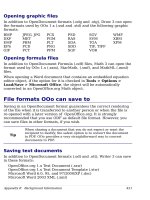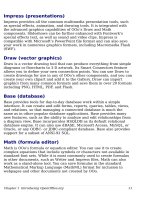Getting Started with Open Office .org 3 part 23 pps
Bạn đang xem bản rút gọn của tài liệu. Xem và tải ngay bản đầy đủ của tài liệu tại đây (4.77 MB, 10 trang )
Basic shapes
The Basic Shapes icon makes available the
range of tools for drawing basic shapes.
If you choose the rectangle tool from this
toolbar, it looks the same as a rectangle drawn
using the Rectangle tool on the Drawing
toolbar. The only differences you will see are in
the information field in the status bar.
Symbol shapes
The Symbol Shapes icon brings you to an
array of tools for drawing the various symbol
shapes.
Block arrows
The Block Arrows icon opens the Block Arrows
toolbar.
Flowcharts
The tools for drawing flowcharts are accessed by
clicking on the Flowcharts icon .
The creation of flowcharts, organization charts, and
similar planning tools are described in Chapter 9
(Organization Charts, Flow Diagrams, and More) in
the
Draw Guide.
Callouts
Use the Callouts icon to open the Callouts
toolbar.
Chapter 7 Getting Started with Draw 221
Stars and banners
These tools are associated with the Stars icon
.
You can add text to all these shapes. See Chapter 2 (Drawing Basic
Shapes) and Chapter 10 (Advanced Draw Techniques) in the
Draw
Guide
for details.
Selection modes
There are three selection modes: moving and changing size, rotating,
and editing points.
The default mode for selecting objects depends on whether the Points
button on the Drawing toolbar is active (appears lit) or not inactive
(appears dark or dimmed) .
In standard mode (when you begin a new drawing),
the Points button is not active, and the default mode
is for selections to be moved or changed in size; these
selections are indicated by small green squares.
When the Points button is active, the default mode is
for selections to be edited; these selections are
indicated by blue squares. Some objects will have one
or more extra handles, which are larger or colored
differently. This is explained in more detail in the
Draw Guide
.
Selections for rotating objects are indicated by small
red circles and a symbol representing the center of
rotation. To choose these selections, click on the
Effects drop-down button from the Drawing
toolbar.
222 Getting Started with OpenOffice.org 3
Changing the selection mode
To go from one mode to another, you can do one of the following:
• Toggle the Points button on the Drawing toolbar to switch from
the simple selection mode to the Points mode . You can also use
the keyboard shortcut
F8
(Points).
• Choose the Effects drop-down button from the Drawing toolbar
to activate the Rotation mode for a selected object.
• If you often work in Rotation mode, you can choose the Rotation
Mode after Clicking Object button from the Options bar, you
can cycle through normal and rotation modes just by clicking on
the object. This can be more convenient than clicking the object,
then clicking the Rotate button from the Drawing Toolbar.
Selecting objects
Direct selection
To select an object, the easiest way is to click directly on it. For objects
that are not filled, click directly on the object's outline to select it.
Selection by framing
You can select several objects by using the mouse to
drag a large rectangle around the objects, as shown.
For this to work, the Select icon on the Drawing
toolbar must be active. Only objects that lie entirely
within the rectangle are selected.
Selecting hidden objects
Even if objects are located behind others and not visible, they can still
be selected. To select an object that is covered by another object, hold
down the
Alt
key and click the object. To select an object that is
covered by several objects, hold down the
Alt
key and click through the
objects until you reach the required underlying object. To cycle
through the objects in reverse order, hold down the
Alt+Shift
keys
when you click. To help in making accurate selections, you can check
the number and type of the selected objects, shown at the left of the
status bar.
Chapter 7 Getting Started with Draw 223
Note
There may be some variation in the use of the
Alt
key on
different operating systems. In general the
Alt
key on a
Windows computer functions as described above, but on a
Linux system it usually does not. If the
Alt
key on your system
does not operate as described above, use the
Tab
key method
described below.
To select an object that is covered by another object using the
keyboard, press
Tab
to cycle through the objects, stopping at the
object you wish to select. To cycle through the objects in reverse order,
press
Shift+Tab
. This may not be practical if you have a large number
of objects in your drawing.
When you click on the selected object, its outline
appears briefly through the objects on top of the
selected object.
In the illustration to the right, the square located
beneath the circle was selected in this way (the circle
was made transparent in order to see the square).
Arranging objects
In a complex drawing, you may have objects stacked up, one on top of
the other, with the result that a particular object is hidden by one or
more other objects above it. You can rearrange the stacking order of
objects (move an object to the front or to the back of the stack) by
selecting the object, clicking Modify > Arrange and selecting the
appropriate Bring Forward or Send Backward option, or by right-
clicking the object and selecting Arrange from the context menu, then
selecting from the list of Bring Forward or Send Backward options.
On the Drawing toolbar, the Arrange tear-off menu on the button
contains the above options. A keyboard shortcut is
Shift+Ctrl++
to
bring an object to the top, and
Shift+Ctrl+
− to send an object to the
bottom.
Draw also provides tools for aligning multiple objects; details are given
in the
Draw Guide
.
Selecting several objects
To select or deselect several objects one by one, press the
Shift
key
and click on the various objects to be selected or deselected. One click
on an object selects it; a second click deselects it.
224 Getting Started with OpenOffice.org 3
Moving and dynamically adjusting an
object’s size
There are several ways of moving or changing the size of an object.
The method described here will be called
dynamic
in the sense that it
is carried out using the mouse.
When you dynamically change an object, remember to check the
central area of the status bar at the bottom of your screen. This area
shows detailed information about the ongoing manipulation. For
example, during resizing, you will see the following information
displayed. This information changes when the mouse is moved.
Dynamic movement of objects
To move an object, select it and then click within
the object’s border and hold down the left mouse
button while moving the mouse. To drop the
object at its new location, release the mouse
button.
During movement, the shape of the object
appears as dotted lines to help with
repositioning.
If you have selected Guides when moving in
Tools > Options > OpenOffice.org Draw >
View, then during movement, dotted lines
appear, to help with repositioning.
Chapter 7 Getting Started with Draw 225
Object position Object dimensions Current proportional page size
Dynamic size modification of objects
To change the size of an object (or group of
selected objects) with the mouse, you need to move
one of the handles located around the selection. As
shown in the following illustration, the outline of
the resulting new object appears as a dotted line.
The results differ depending on which handle you use. If you choose a
corner handle, you will resize the object along two axes at the same
time. If you use a side handle, the objects will only be resized along
one axis.
Note
If you press the
Shift
key at the same time as you carry out the
resizing operation, the size change will be carried out
symmetrically with respect to the two axes; this enables you to
keep the aspect (height/length) ratio of the object.
Rotation
Rotating an object lets you move the object around an axis. To do this
dynamically, use the red handles, as you do when changing the size of
the object.
Note
Rotation works in a slightly different way for 3D objects
because the rotation occurs in 3D space and not in one plane.
See Chapter 7 (Working with 3D Objects) in the
Draw Guide
regarding rotation when Edit Points mode is active.
To rotate an object (or a group of objects), drag the red corner handle
points of the selection with the mouse. The mouse cursor takes the
shape of an arc of a circle with an arrow at each end. A dotted outline
of the object being rotated appears and the current angle of rotation is
dynamically shown in the status bar.
Rotations are made about an axis which is displayed as a small symbol.
You can move the axis of rotation with the mouse, as shown in
Figure 169.
If you hold down the
Shift
key during the rotation, the operation will be
carried out in increments of 15°.
226 Getting Started with OpenOffice.org 3
Figure 169: Rotating an object
Inclination and perspective
To slant or shear objects, use the red handles located at the midpoint
of an edge of the selected objects. The mouse pointer changes to a
when the pointer hovers over one of these midpoint handles. Not every
object can be slanted—basic shapes can be rotated but not slanted.
The slant axis is the point directly opposite the midpoint handle to be
used for shearing the object. This point stays fixed in location; the
other sides and edges move in relation to it as the mouse is dragged
(make sure that the handle icon is showing before dragging).
As with rotation, you can set the inclination to occur as steps of 15° by
pressing the
Shift
key while moving the handle.
Editing objects
To change an object’s attributes (such as color, border width, among
others) you can use the Line and Filling toolbar or the context menu.
If the Line and Filling toolbar (Figure 170) is not visible, you can
display it using View > Toolbars > Line and Filling. From here you
can edit the most common object attributes. You can also open the Line
dialog by clicking on the Line icon and the Area dialog by clicking
on the Area icon to see more options.
Chapter 7 Getting Started with Draw 227
1 Styles and Formatting
2 Line
3 Arrow Style
4 Line Style
5 Line Width
6 Line Color
7 Area
8–9 Area Style / Filling
10 Shadow
Figure 170: Line and Filling toolbar
When you select text, this toolbar changes to show text formatting
options (Figure 171).
Figure 171: Line and Filling toolbar (when text is selected)
The context menu
When an object is selected, you can right-click on the object to bring
up a context menu, which provides additional access to the options
shown above and another way to change an object’s attributes. The
entries with a small arrow on the right-hand side contain a submenu.
Editing lines and borders
Lines (like arrows) and the borders of an
object are managed through the same dialog.
An object’s border is just another type of line.
You can change some properties from the Line and Filling toolbar. To
see more options, select the object and click on the Line icon or
right-click on the object and choose Line from the context menu. This
opens the Line dialog.
Common line properties
In most cases the property you want to change is the line’s style (solid,
dashed, invisible, and so on), its color, or its width. These options are
all available from the Line and Filling toolbar (Figure 170).
You can also edit these properties from the Line dialog, where you can
also change the line’s transparency. Figure 172 illustrates different
degrees of transparency.
228 Getting Started with OpenOffice.org 3
Figure 172: The vertical lines have different
levels of transparency (0%, 25%, and 50%).
Drawing arrows
Arrowheads (and other line endings, usually referred to
collectively as arrows) are a line property. Select a line and
click on the Arrow Style icon. This opens the
Arrowheads menu.
Several types of arrowheads are available. Each end of the
line can have a different arrowhead (or no arrowhead).
Arrowheads are only applicable to lines. They have no
effect on an object’s border.
Customizing line and arrow styles
You can modify the line and arrow styles and create your own. See
Chapter 4 (Changing Object Attributes) in the
Draw Guide
for details.
Editing the inside (fill) of an object
The OpenOffice.org term for the inside of an object is Area fill. The
area fill of an object can be a uniform color, a gradient, a hatching, or a
pattern from an image. It can be made partly or wholly transparent
and can throw a shadow.
Chapter 7 Getting Started with Draw 229
In most cases, you will choose one of the standard fill options, which
are all available from the Line and Filling toolbar. You can also define
your own area fills; see Chapter 4 of the
Draw Guide
for details.
Adding a shadow
In Draw, shadows are considered an area
property. Click on the Shadow icon on the Line
and Filling toolbar.
You can customize the position, distance, color,
and transparency of shadows.
Adding transparency
You can make objects partly or fully transparent, or even with a
varying degree of transparency (as a gradient).
Using styles
Suppose that you want to apply the same area fill, line thickness, and
border to a set of objects. This repetitive process can be greatly
simplified by the use of styles. Styles allow you to define a formatting
template (a style) and then to apply that style to multiple objects. For
more about styles, see Chapter 3 (Using Styles and Templates) for
more information.
Special effects
With Draw, you can apply many special effects to objects and groups of
objects. This section describes a few of these effects. Others include
distorting, shadows, and transparency. See the
Draw Guide
for
examples of the many effects available.
Flip an object
Select an object and click on the Flip icon . You will
see a dashed line through the middle of the object.
230 Getting Started with OpenOffice.org 3









